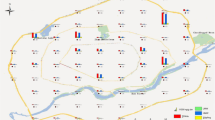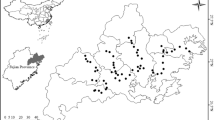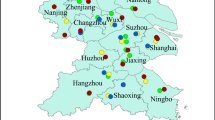Abstract
Purpose
A comprehensive study was conducted to investigate the presence of polycyclic aromatic hydrocarbons (PAHs) in Dongjiang River Basin (DRB) soils and to evaluate their sources and ecological and health risk. In addition, factors affecting the distribution and fate of PAHs in the soils such as emission density, soil organic matter, degradation, etc. were studied.
Materials and methods
Surface soil (0–20 cm) samples from 30 sampling sites in the rural areas of DRB were collected and analyzed for 17 polycyclic aromatic hydrocarbons (16 EPA priority PAHs and perylene). Positive matrix factorization model was used to investigate the source apportionment of these PAHs, and an incremental lifetime cancer risk (ILCR) was used to estimate the integrated lifetime risks of exposure to soil-borne PAHs through direct ingestion, dermal contact, and inhalation collectively.
Results and discussion
The total PAH concentrations in the rural soils in DRB range from 23.5 to 231 μg/kg with a mean concentration of 116 μg/kg. The predominant PAHs in the rural soils were naphthalene, fluoranthene, phenanthrene, and benzo(b)fluoranthene. Cluster analysis was performed to classify the soil PAHs into three clusters, which could be indicative of the soil PAHs with different origins and different properties. Source apportionment results showed that coal, biomass, oil, commercial creosotes, and vehicle contributed 24 %, 24 %, 17 %, 17 %, and 18 % of the total soil PAH burden, respectively. The ILCR results indicated that exposure to these soil-borne PAHs through direct ingestion, dermal contact, and inhalation collectively produces some risk.
Conclusions
PAHs in the soils of the DRB will produce long-term influences on rivers and oceans via soil erosion and river transport. Therefore, PAHs in rural soils of DRB have potential impacts on the water supply and human health risk.








Similar content being viewed by others
References
Aannokkee GJ (1990) MT-TNO research into the biodegradation of soils and sediments contaminated with oils and PAHs. In: Wolf K (ed) Contaminated soil. Academic, New York
Anttila P, Paatero P, Tapper U, Järvinen O (1995) Source identification of bulk wet deposition in Finland by positive matrix factorization. Atmos Environ 14:1705–1718
Atanassova I, Brummer GW (2004) Polycyclic aromatic hydrocarbons of anthropogenic and biopedogenic origin in a colluviated hydromorphic soil of Western Europe. Geoderma 120:27–34
Azuma H, Toyota M, Asakawa Y, Kawano S (1996) Naphthalene—a constituent of magnolia flowers. Phytochemistry 42:999–1004
Chen CW, Chen CF, Dong CD, Tu YT (2012) Composition and source apportionment of PAHs in sediments at river mouths and channel in Kaohsiung Harbor, Taiwan. J Environ Monit 14:105–115
Chen LG, Ran Y, Xing BS, Mai BX, He JH, Wei XG, Fu JM, Sheng GY (2005) Contents and sources of polycyclic aromatic hydrocarbons and organochlorine pesticides in vegetable soils of Guangzhou, China. Chemosphere 60:879–890
Colombo JC, Cappelletti N, Lasci J, Migoya MC, Spearanza E, Skopurka CN (2006) Sources, vertical fluxes, and equivalent toxicity of aromatic hydrocarbons in coastal sediments of the Rio de la Plata Estuary, Argentina. Environ Sci Technol 40:734–740
Cornelissen G, Gustafsson O, Bucheli TD, Jonker MTO, Koelmans AA, VanNoort PCM (2005) Extensive sorption of organic compounds to black carbon, coal, and kerogen in sediments and soils: mechanisms and consequences for distribution, bioaccumulation, and biodegradation. Environ Sci Technol 39:6881–6895
Dickhut RM, Canuel EA, Gustafson KE, Liu K, Arzayus KM, Walker SE, Edgecombe G, Gaylor MO, MacDonald EH (2000) Automotive sources of carcinogenic polycyclic aromatic hydrocarbons associated with particulate matter in the Chesapeake Bay region. Environ Sci Technol 34:4635–4640
Freeman DJ, Cattell FCR (1990) Wood-burning as a source of atmospheric polycyclic aromatic-hydrocarbons. Environ Sci Technol 24:1581–1585
Gordon GE (1988) Receptor models. Environ Sci Technol 22:1132–1142
Gu SH, Kralovec AC, Christensen ER, Van-Camp RP (2003) Source apportionment of PAHs in dated sediments from the Black River, Ohio. Water Res 37:2149–2161
Kameda Y, Shirai J, Komai T, Nakanishi J, Masunaga S (2005) Atmospheric polycyclic aromatic hydrocarbons: size distribution, estimation of their risk and their depositions to the human respiratory tract. Sci Total Environ 340:71–80
Karickhoff SW (1984) Organic pollutant sorption in aquatic systems. J Hydraul Eng 110:707–735
Kim E, Hopke PK (2007) Source identifications of airborne fine particles using positive matrix factorization and U.S. Environmental Protection Agency positive matrix factorization. J Air Waste Manag Assoc 57:811–819
Kipopoulou E, Samara MC (1999) Bioconcentration of polycyclic aromatic hydrocarbons in vegetables grown in an industrial area. Environ Pollut 106:369–380
Larsen RK, Baker JE (2003) Source apportionment of polycyclic aromatic hydrocarbons in the urban atmosphere: a comparison of three methods. Environ. Part Sci Technol 37:1873–1881
Li A, Jiang JK, Scheff PA (2003) Application of EPA CMB8.2 Model for Source Apportionment of Sediment PAHs in Lake Calumet, Chicago. Environ Sci Technol 37:2958–2965
Liao CM, Chiang KC (2006) Probabilistic risk assessment for personal exposure to carcinogenic polycyclic aromatic hydrocarbons in Taiwanese temples. Chemosphere 63:1610–1619
Liu W, Hopke PK, Han YJ, Yi SM, Holsen TM, Cybart S, Kozlowski K, Milligan M (2003) Application of receptor modeling to atmospheric constituents at Potsdam and Stockton, NY. Atmos Environ 37:4997–5007
Ma XX, Ran Y, Gong J, Zou MY (2008) Concentrations and inventories of polycyclic aromatic hydrocarbons and organochlorine pesticides in watershed soils in the Pearl River Delta. China. Environ Monit Assess 145:453–464
Mai BX, Fu JM, Sheng GY, Kang YH, Lin Z, Zhang G, Min YS, Zeng EY (2002) Chlorinated and polycyclic aromatic hydrocarbons in riverine and estuarine sediments from Peart River Delta, China. Environ Pollut 117:457–474
Meijer SN, Ockenden WA, Sweetman A, Breivik K, Grimal JO, Jones KC (2003) Global distribution and budget of PCBs and HCB in background surface soils: implications for sources and environmental processes. Environ Sci Technol 37:667–672
Nam JJ, Song BH, Eom KC, Lee SH, Smith A (2003) Distribution of polycyclic aromatic hydrocarbons in agricultural soils in South Korea. Chemosphere 50:1281–1289
Nam JJ, Thomas GO, Jaward FM, Steinnes E, Gustafsson O, Jones KC (2008) PAHs in background soils from Western Europe: influence of atmospheric deposition and soil organic matter. Chemosphere 70:1596–1602
Neff JM (1979) Polycyclic Aromatic Hydrocarbons in the Aquatic Environment. Applied Science Publishers, London
Paatero P (1997) Least square formulation of robust non-negative factor analysis. Chemometr Intell Lab 37:23–35
Paatero P, Tapper U (1994) Positive matrix factorization: a non-negative factor model with optimal utilization of error estimates of data values. Environmetrics 5:111–126
Peng C, Chen WP, Liao XL, Wang M, Ouyang ZY, Jiao WT, Bai Y (2011) Polycyclic aromatic hydrocarbons in urban soils of Beijing: status, sources, distribution and potential risk. Environ Pollut 159:802–808
Peters CA, Knightes CD, Brown DG (1999) Long-term composition dynamics of PAH-containing NAPLs and implications for risk assessment. Environ Sci Technol 33:4499–4507
Phillips DH (1999) Polycyclic aromatic hydrocarbons in the diet. Mutat Res-Gen Tox En 443:139–147
Rajput N, Khemani LD, Lakhani A (2008) Polycyclic aromatic hydrocarbons in ambient air at Agra: distribution and toxicity assessment. Environ Sci Eng 50:111–114
Ran Y, Huang WL, Rao PSC, Liu DH, Sheng GY, Fu JM (2002) The role of condensed organic matter in the nonlinear sorption of hydrophobic organic contaminants by a peat and sediments. J Environ Qual 31:1952–1962
Ran Y, Xiao BH, Huang WL, Peng PA, Liu DH, Fu JM, Sheng GY (2003) Kerogen in aquifer material and its strong sorption for nonionic organic pollutants. J Environ Qual 32:1701–1709
Schwarzenbach RP, Escher BI, Fenner K, Hofstetter TB, Johnson CA, Von Gunten U, Wehrli B (2006) The challenge of micropollutants in aquatic systems. Science 313:1072–1077
Soonthornnonda P, Zou YH, Christensen ER, Li A (2011) PCBs in Great Lakes sediments, determined by positive matrix factorization. J Great Lakes Res 37:54–63
Szabová E, Zeljenková D, Nescáková E, Simko M, Turecký L (2008) Polycyclic aromatic hydrocarbons and occupational risk factor. Reprod Toxicol 26:74
Tao S, Cui YH, Xu FL, Li BG, Cao J, Liu WX, Schmitta G, Wang XJ, Shen WR, Qing BP, Sun R (2004) Polycyclic aromatic hydrocarbons (PAHs) in agricultural soil and vegetables from Tianjin. Sci Total Environ 320:11–24
Ulbrich IM, Canagaratna MR, Zhang Q, Worsnop DR, Jimenez JL (2009) Interpretation of organic components from positive matrix factorization of aerosol mass spectrometric data. Atmos Chem Phys 9:2891–2918
US EPA (2008) EPA positive matrix factorization (PMF) 3.0 fundamentals & user guide. Available online at http://www.epa.gov/heasd/products/pmf/pmf.html
Voutsa C, Samara C (1998) Dietary intake of trace elements and polycyclic aromatic hydrocarbons via vegetables grown in an industrial Greek area. Sci Total Environ 218:203–216
Wang X, Zuo Q, Duan Y, Liu W, Cao J, Tao S (2012) Factors affecting spatial variation of polycyclic aromatic hydrocarbons in surface soils in North China Plain. Environ Toxicol Chem 31:2246–2252
Wang D, Tian F, Yang M, Liu C, Li YF (2009) Application of positive matrix factorization to identify potential sources of PAHs in soil of Dalian, China. Environ Pollut 157:1559–1564
Wang XT, Miao Y, Zhang Y, Li YC, Wu MH, Yu G (2013) Polycyclic aromatic hydrocarbons (PAHs) in urban soils of the megacity Shanghai: occurrence, source apportionment and potential human health risk. Sci Total Environ 447:80–89
Wilcke W (2000) Polycyclic aromatic hydrocarbons (PAHs) in soil—a review. J Soil Sci Plant Nut 163:229–248
Wild SR, Jones KC (1995) Polynuclear aromatic hydrocarbons in the United Kingdom environment: a preliminary source inventory and budget. Environ Pollut 88:91–108
Wu YP, Chen J (2009) Simulation of nitrogen and phosphorus loads in the Dongjiang River basin in South China using SWAT. Front Earth Sci China 3:273–278
Xie M, Hannigan MP, Dutton SJ, Milford JB, Hemann JG, Miller SL, Schauer JJ, Peel JL, Vedal S (2012) Positive matrix factorization of PM (2.5): comparison and implications of using different speciation data sets. Environ Sci Technol 46:11962–11970
Yang Y, Zhang N, Xue M (2010) Tao S (2010) Impact of soil organic matter on the distribution of polycyclic aromatic hydrocarbons (PAHs) in soils. Environ Pollut 158:2170–2174
Yu Y, Guo H, Liu Y, Huang K, Wang Z, Zhan X (2008) Mixed uncertainty analysis of polycyclic aromatic hydrocarbon inhalation and risk assessment in ambient air of Beijing. J Environ Sci (China) 20:505–512
Yunker MB, Macdonald RW, Vingarzan R, Mitchelld RH, Goyette D, Sylvestre S (2002) PAHs in the Fraser River basin: a critical appraisal of PAH ratios as indicators of PAH source and composition. Org Geochem 33:489–515
Zakaria MP, Takada H, Tsutsumi S, Ohno K, Yamada J, Kouno E, Kumata H (2002) Distribution of Polycyclic Aromatic Hydrocarbons (PAHs) in Rivers and Estuaries in Malaysia: A Widespread Input of Petrogenic PAHs. Environ Sci Technol 36:1907–1918
Zhang G, Parker A, House A, Mai BX, Li XD, Kang YH, Wang ZS (2002) Sedimentary records of DDT and HCH in the Pearl River Delta, South China. Environ Sci Technol 36:3671–3677
Zhang HB, Luo YM, Wong MH, Zhao QG, Zhang GL (2006) Distributions and concentrations of PAHs in Hong Kong Soils. Environ Pollut 141:107–114
Zhang YX, Tao S, Cao J, Coveney JRRM (2007) Emission of polycyclic aromatic hydrocarbons in China by county. Environ Sci Technol 41:684–687
Zuo Q, Duan YH, Yang Y, Wang XJ, Tao S (2007) Source apportionment of polycyclic aromatic hydrocarbons in surface soil in Tianjin, China. Environ Pollut 147:303-310
Acknowledgments
This research was financially supported by a key project of NNSFC—Guangdong (U1201235), GIGCAS 135 project (Y234081001), a general project, and a “Team Program” project of the National Natural Science Foundation of China (project nos. 40972222 and 41121063), which were much appreciated. This is contribution no. IS-1701 from GIGCAS.
Author information
Authors and Affiliations
Corresponding author
Additional information
Responsible editor: Bernd Markert
Electronic supplementary material
Below is the link to the electronic supplementary material.
ESM 1
One table listing the sampling sites and two figures showing the relationship between total PAHs and TOC, and factor profiles of individual PAH compounds in the five factors identified by PMF mode, respectively, are available on the website. (DOC 1774 kb)
Rights and permissions
About this article
Cite this article
Zheng, T., Ran, Y. & Chen, L. Polycyclic aromatic hydrocarbons (PAHs) in rural soils of Dongjiang River Basin: occurrence, source apportionment, and potential human health risk. J Soils Sediments 14, 110–120 (2014). https://doi.org/10.1007/s11368-013-0753-8
Received:
Accepted:
Published:
Issue Date:
DOI: https://doi.org/10.1007/s11368-013-0753-8




